Abstract
1 The effect of amantadine hydrochloride on various aspects of catecholamine metabolism in the rat brain has been investigated. 2 Amantadine failed to have any significant effect on brain concentrations of dopamine or noradrenaline even when administered daily for 9 days. 3 Amantadine had no effect on the rate of decline of noradrenaline and dopamine concentrations after alpha-methyl-p-tyrosine. 4 In vitro amantadine inhibited dopamine uptake into synaptosomes only at high concentrations, and caused little release of dopamine from synaptosomes. 5 There is no evidence from these results to suggest that the anti-Parkinsonian effect of amantadine is related to an action on dopaminergic mechanisms.
Full text
PDF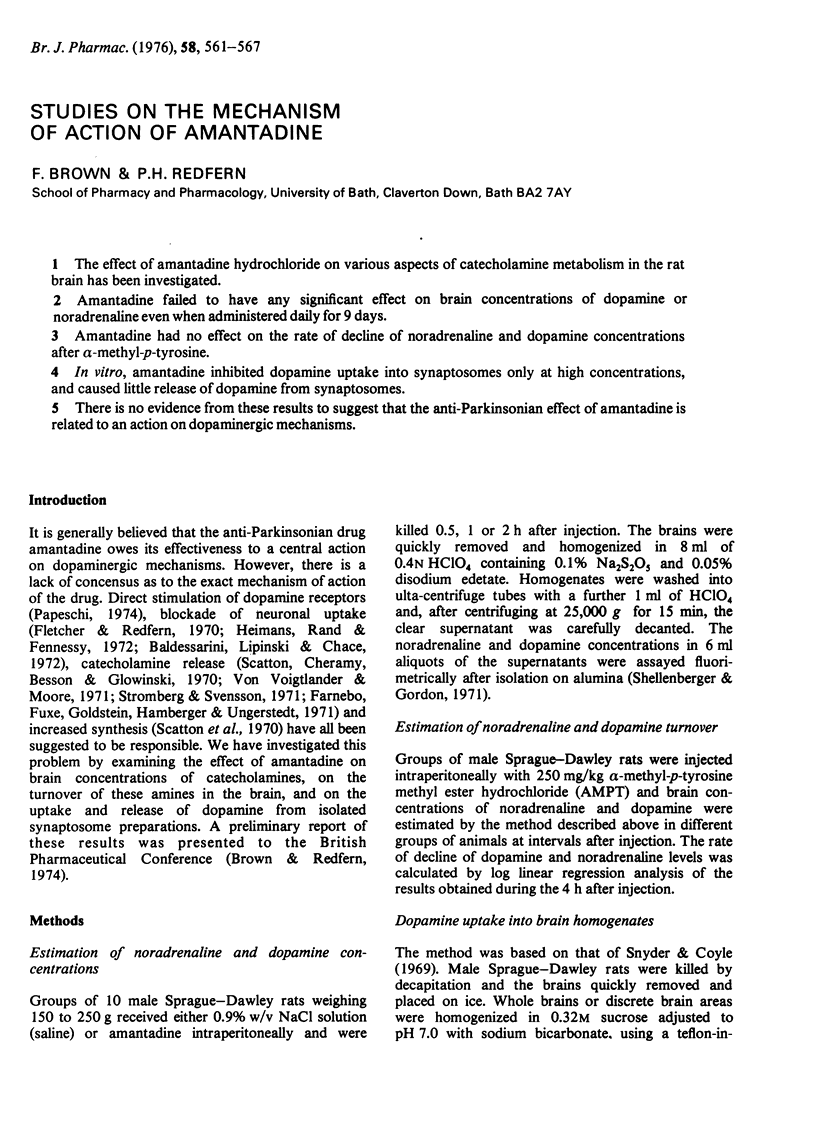
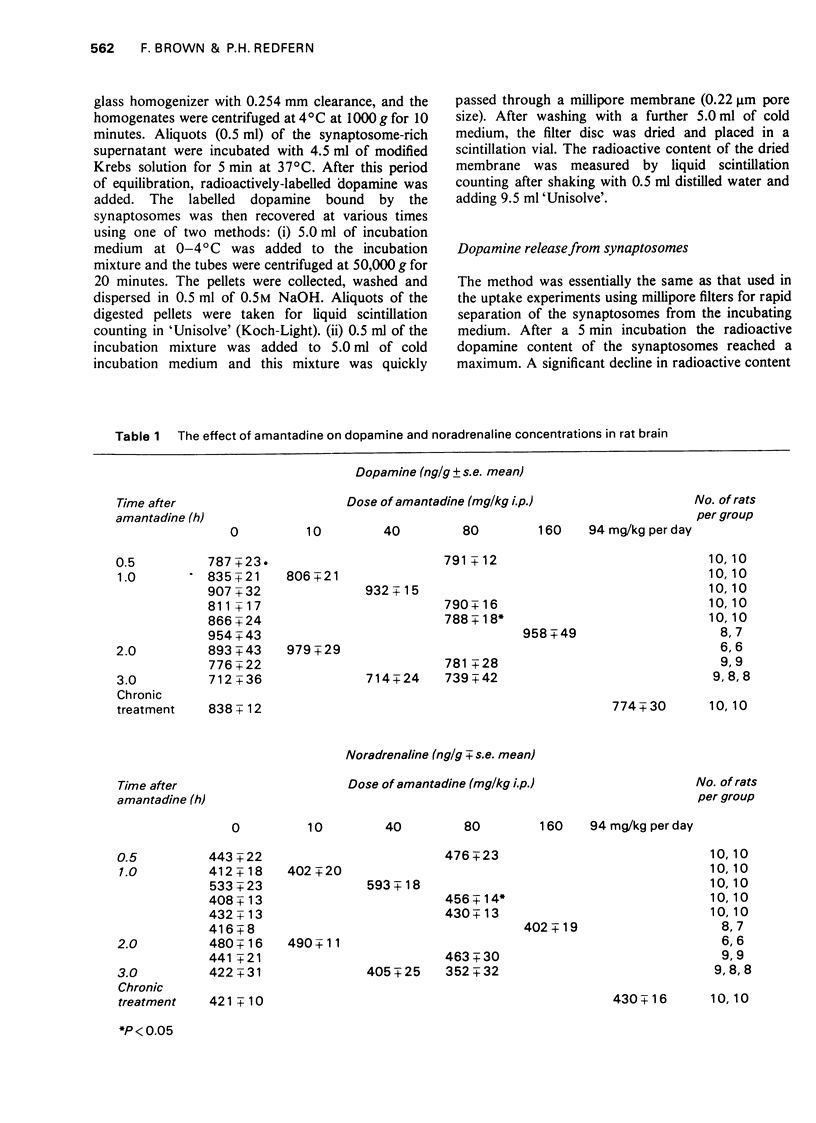
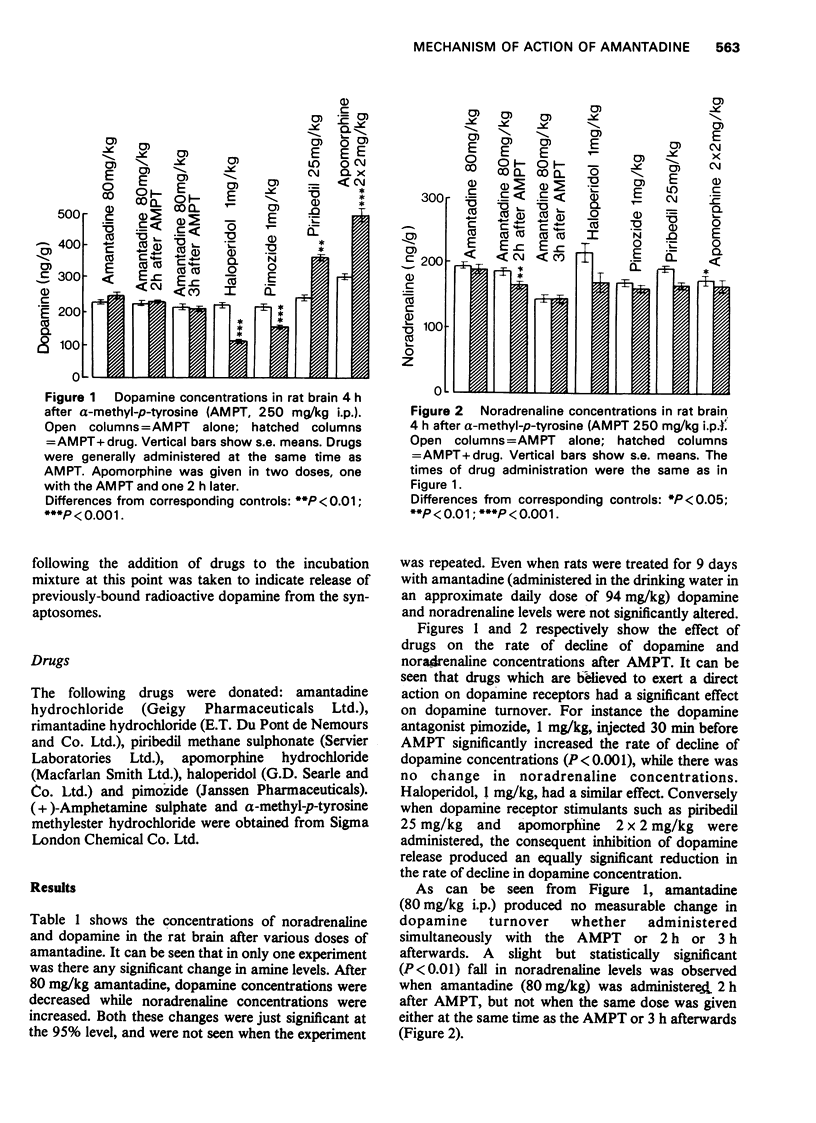
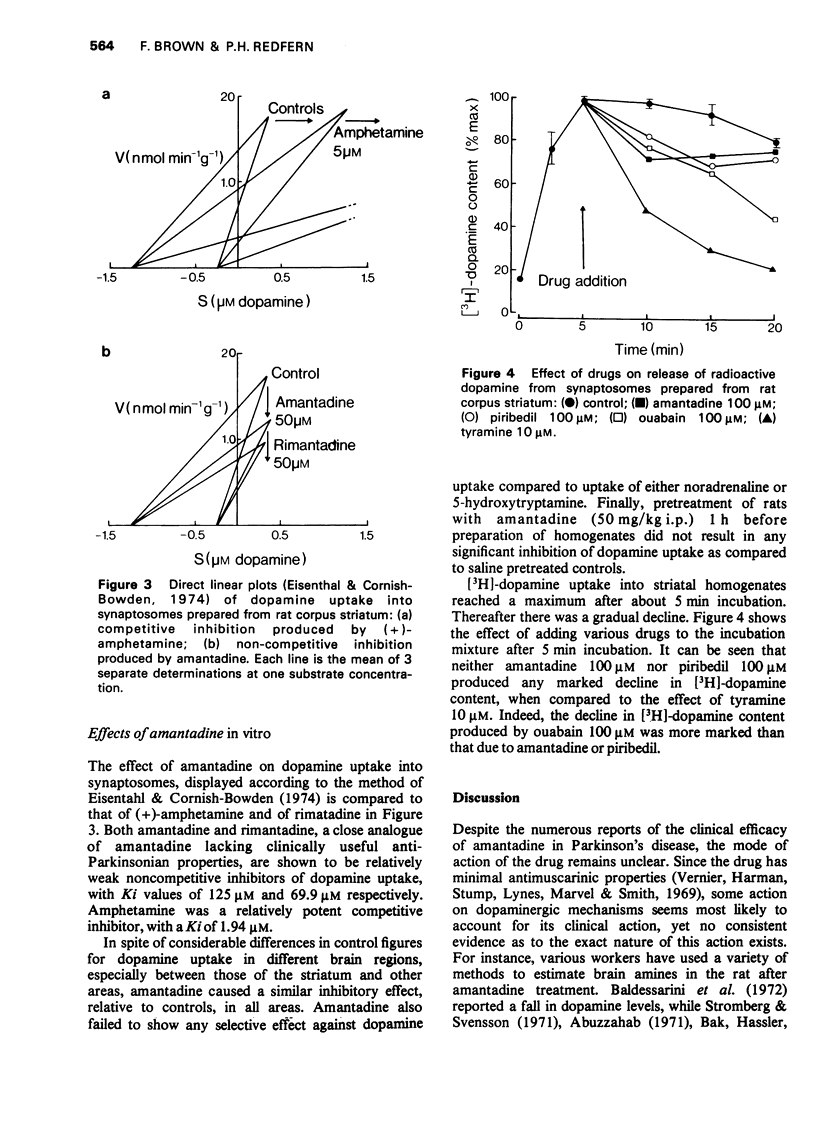
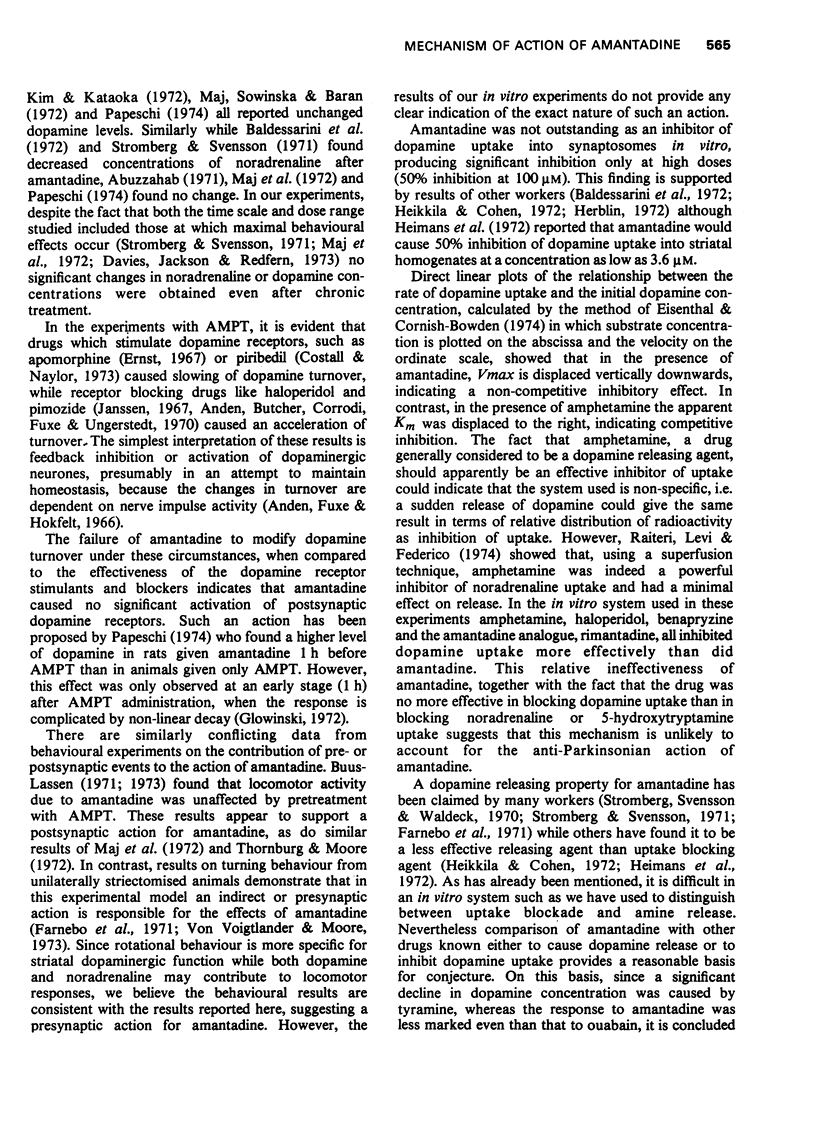
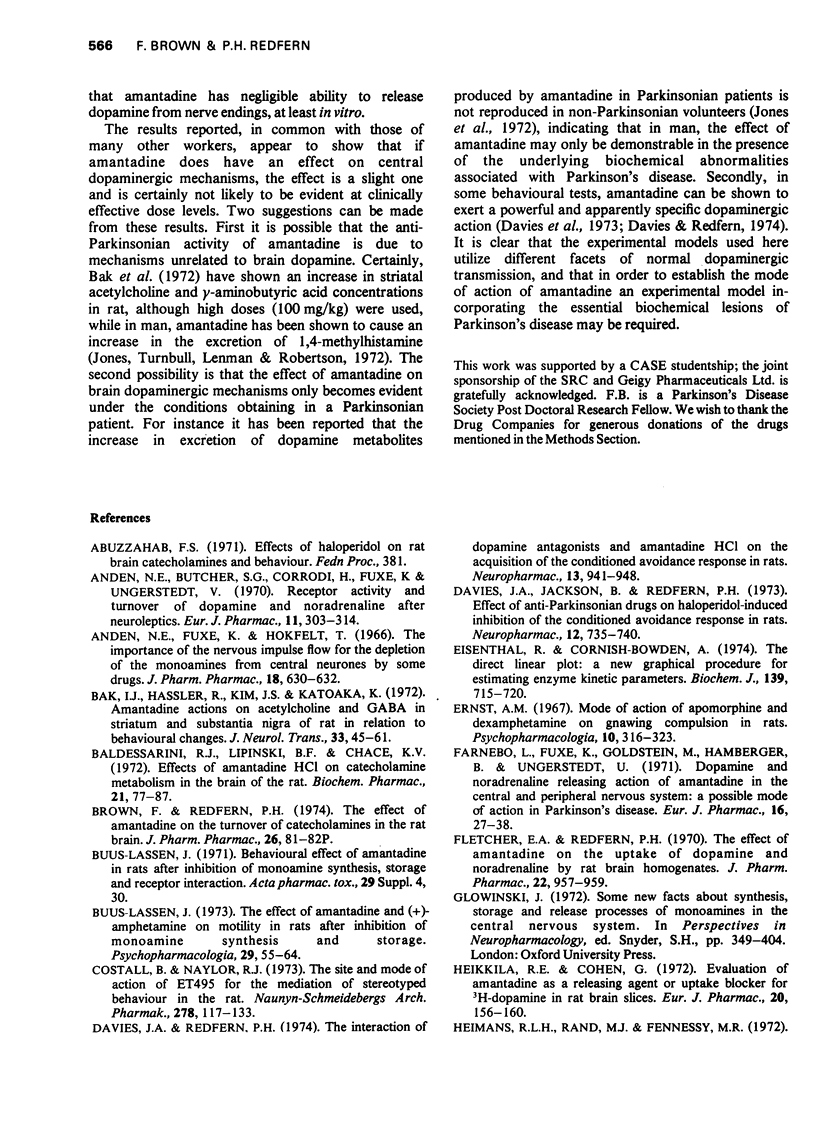
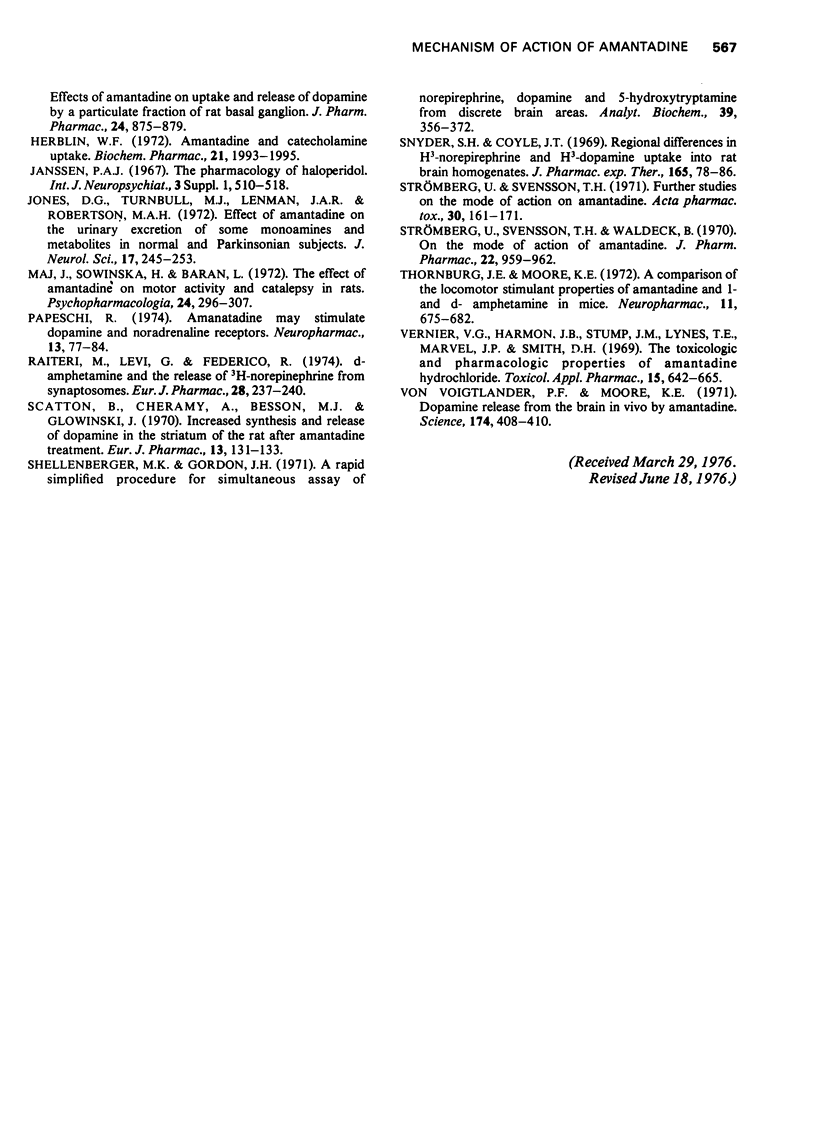
Selected References
These references are in PubMed. This may not be the complete list of references from this article.
- Andén N. E., Butcher S. G., Corrodi H., Fuxe K., Ungerstedt U. Receptor activity and turnover of dopamine and noradrenaline after neuroleptics. Eur J Pharmacol. 1970;11(3):303–314. doi: 10.1016/0014-2999(70)90006-3. [DOI] [PubMed] [Google Scholar]
- Andén N. E., Fuxe F., Hökfelt T. The importance of the nervous impulse flow for the depletion of the monoamines from central neurones by some drugs. J Pharm Pharmacol. 1966 Sep;18(9):630–632. doi: 10.1111/j.2042-7158.1966.tb07949.x. [DOI] [PubMed] [Google Scholar]
- Bak I. J., Hassler R., Kim J. S., Kataoka K. Amantadine actions on acetylcholine and GABA in striatum and substantia nigra of rat in relation to behavioral changes. J Neural Transm. 1972;33(1):45–61. doi: 10.1007/BF01244727. [DOI] [PubMed] [Google Scholar]
- Baldessarini R. J., Lipinski J. F., Chace K. V. Effects of amantadine hydrochloride on catecholamine metabolism in the brain of the rat. Biochem Pharmacol. 1972 Jan;21(1):77–87. doi: 10.1016/0006-2952(72)90252-3. [DOI] [PubMed] [Google Scholar]
- Brown F., Redfern P. H. Proceedings: The effect of amantadine on the turnover of catecholamines in the rat brain. J Pharm Pharmacol. 1974 Dec;26 (Suppl):81P–82P. doi: 10.1111/j.2042-7158.1974.tb10106.x. [DOI] [PubMed] [Google Scholar]
- Costall B., Naylor R. J. The site and mode of action of ET495 for the mediation of stereotyped behaviour in the rat. Naunyn Schmiedebergs Arch Pharmacol. 1973;278(2):117–133. doi: 10.1007/BF00500645. [DOI] [PubMed] [Google Scholar]
- Davies J. A., Jackson B., Redfern P. H. The effect of anti-Parkinsonian drugs on haloperidol-induced inhibition of the conditioned-avoidance response in rats. Neuropharmacology. 1973 Aug;12(8):735–740. doi: 10.1016/0028-3908(73)90013-0. [DOI] [PubMed] [Google Scholar]
- Davies J. A., Redfern P. H. The interaction of dopamine-antagonists and amantadine hydrochloride on the acquisition of the conditioned avoidance response in rats. Neuropharmacology. 1974 Nov;13(10-11):941–948. doi: 10.1016/0028-3908(74)90085-9. [DOI] [PubMed] [Google Scholar]
- Eisenthal R., Cornish-Bowden A. The direct linear plot. A new graphical procedure for estimating enzyme kinetic parameters. Biochem J. 1974 Jun;139(3):715–720. doi: 10.1042/bj1390715. [DOI] [PMC free article] [PubMed] [Google Scholar]
- Ernst A. M. Mode of action of apomorphine and dexamphetamine on gnawing compulsion in rats. Psychopharmacologia. 1967;10(4):316–323. doi: 10.1007/BF00403900. [DOI] [PubMed] [Google Scholar]
- Farnebo L. O., Fuxe K., Goldstein M., Hamberger B., Ungerstedt U. Dopamine and noradrenaline releasing action of amantadine in the central and peripheral nervous system: a possible mode of action in Parkinson's disease. Eur J Pharmacol. 1971 Sep;16(1):27–38. doi: 10.1016/0014-2999(71)90053-7. [DOI] [PubMed] [Google Scholar]
- Fletcher E. A., Redfern P. H. The effect of amantadine on the uptake of dopamine and noradrenaline by rat brain homogenates. J Pharm Pharmacol. 1970 Dec;22(12):957–959. doi: 10.1111/j.2042-7158.1970.tb08486.x. [DOI] [PubMed] [Google Scholar]
- Heikkila R. E., Cohen G. Evaluation of amantadine as a releasing agent or uptake blocker for H 3 -dopamine in rat brain slices. Eur J Pharmacol. 1972 Nov;20(2):156–160. doi: 10.1016/0014-2999(72)90144-6. [DOI] [PubMed] [Google Scholar]
- Herblin W. F. Amantadine and catecholamine uptake. Biochem Pharmacol. 1972 Jul 15;21(14):1993–1995. doi: 10.1016/0006-2952(72)90013-5. [DOI] [PubMed] [Google Scholar]
- Jones D. G., Turnbull M. J., Lenman J. A., Robertson M. A. Effect of amantadine on the urinary excretion of some monoamines and metabolites in normal and Parkinsonian subjects. J Neurol Sci. 1972 Nov;17(3):245–253. doi: 10.1016/0022-510x(72)90030-5. [DOI] [PubMed] [Google Scholar]
- Lassen J. B. The effect of amantadine and (+)-amphetamine on motility in rats after inhibition of monoamine synthesis and storage. Psychopharmacologia. 1973 Feb 27;29(1):55–64. doi: 10.1007/BF00421211. [DOI] [PubMed] [Google Scholar]
- Maj J., Sowińska H., Baran L. The effect of amantadine on motor activity and catalepsy in rats. Psychopharmacologia. 1972;24(2):296–307. doi: 10.1007/BF00403648. [DOI] [PubMed] [Google Scholar]
- Papeschi R. Amantadine may stimulate dopamine and noradrenaline receptors. Neuropharmacology. 1974 Jan;13(1):77–83. doi: 10.1016/0028-3908(74)90009-4. [DOI] [PubMed] [Google Scholar]
- Raiteri M., Levi G., Federico R. d-amphetamine and the release of 3H-norepinephrine from synaptosomes. Eur J Pharmacol. 1974 Sep;28(1):237–240. doi: 10.1016/0014-2999(74)90140-x. [DOI] [PubMed] [Google Scholar]
- Scatton B., Cheramy A., Besson M. J., Glowinski J. Increased synthesis and release of dopamine in the striatum of the rat after amantadine treatment. Eur J Pharmacol. 1970;13(1):131–133. doi: 10.1016/0014-2999(70)90194-9. [DOI] [PubMed] [Google Scholar]
- Shellenberger M. K., Gordon J. H. A rapid, simplified procedure for simultaneous assay of norepinephrine, dopamine, and 5-hydroxytryptamine from discrete brain areas. Anal Biochem. 1971 Feb;39(2):356–372. doi: 10.1016/0003-2697(71)90426-x. [DOI] [PubMed] [Google Scholar]
- Snyder S. H., Coyle J. T. Regional differences in H3-norepinephrine and H3-dopamine uptake into rat brain homogenates. J Pharmacol Exp Ther. 1969 Jan;165(1):78–86. [PubMed] [Google Scholar]
- Stromberg U., Svensson T. H., Waldeck B. On the mode of action of amantadine. J Pharm Pharmacol. 1970 Dec;22(12):959–962. doi: 10.1111/j.2042-7158.1970.tb08487.x. [DOI] [PubMed] [Google Scholar]
- Strömberg U., Svensson T. H. Further studies on the mode of action of amantadine. Acta Pharmacol Toxicol (Copenh) 1971;30(3):161–171. doi: 10.1111/j.1600-0773.1971.tb00646.x. [DOI] [PubMed] [Google Scholar]
- Thornburg J. E., Moore K. E. A comparison of the locomotor stimulant properties of amantadine and l- and d-amphetamine in mice. Neuropharmacology. 1972 Sep;11(5):675–682. doi: 10.1016/0028-3908(72)90075-5. [DOI] [PubMed] [Google Scholar]
- Vernier V. G., Harmon J. B., Stump J. M., Lynes T. E., Marvel J. P., Smith D. H. The toxicologic and pharmacologic properties of amantadine hydrochloride. Toxicol Appl Pharmacol. 1969 Nov;15(3):642–665. doi: 10.1016/0041-008x(69)90066-0. [DOI] [PubMed] [Google Scholar]
- Von Voigtlander P. F., Moore K. E. Dopamine: release from the brain in vivo by amantadine. Science. 1971 Oct 22;174(4007):408–410. doi: 10.1126/science.174.4007.408. [DOI] [PubMed] [Google Scholar]


